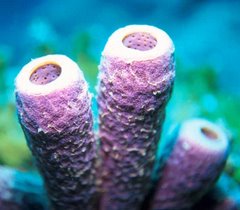Most sea sponges are generally hermaphrodites, meaning they are both male and female, though they can only be one gender at a time. When sponges procreate, they can either reproduce by means of sexual or asexual reproduction.

SEXUAL REPRODUCTION
The process of sexual reproduction between sea sponges occurs in the mesohyl, an acellular gel layer that is the innermost layer of the sponges body. After developing gametes, the "male" sponge will release its sperm into its canals. The sperm is pumped out of the sponge and into the surrounding water by the osculum. Once in the water the sperm cells are then taken into the pore systems of neighbour "female" sponges similarily to how food particles would be. Once inside a female sponge the gametes are collected by collar cells. These cells, also known as choanocytes, then proceed to shed their collars. This process transforms the collar cells into specialized amoeba-like cells which transfter the sperm from the mesohyl to the eggs located in the ovocyte, a cell generating ova. In the majority of sea sponges, the fertilized egg will then develop into a blastula. In some species the blastula will be released into the water directly after fertilization, where in others release is delayed and some development will first take place within the parent sponge. Upon release, the larvae may either settle immediately and grow into an adult spong, or may act planktonically for a few days. The next time the sponges reproduce, they may change sexual roles.
ASEXUAL REPRODUCTION
When reproducing asexually, sea sponges form buds which are also known as gemmules. External buds are formed when fragments of a sea sponge's body are broken off by water currents and carried to other locations. There the buds begin to grow into clones, or genetically identical sponges, of their parents. Some species will produce buds internally rather than externally. These buds are made to survive in extremely unfavorable conditions and this may result in the death of the parent sponge.


No comments:
Post a Comment